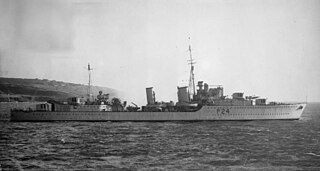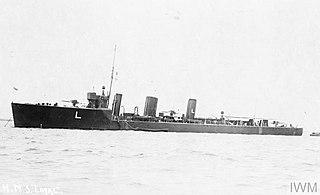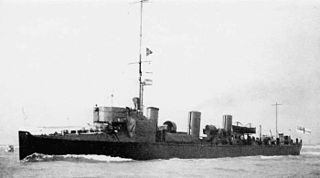Description
Ordered as part of the 1907–1908 Naval Programme, the third batch of Tribal-class destroyers were improved versions of the earlier-batch ships. [1] Maori displaced 1,026 long tons (1,042 t ) at normal load and 1,150 long tons (1,170 t) at deep load. She had an overall length of 285 feet (86.9 m), a beam of 27 feet 1 inch (8.3 m) and a draught of 8 feet 11 inches (2.7 m). The ship was powered by a single steam turbine set which drove three propeller shafts using steam provided by six Yarrow boilers. The turbine was rated at 15,500 shaft horsepower (11,600 kW ) and was intended to give a maximum speed of 33 knots (61 km/h; 38 mph). [2] During her sea trials Maori reached 33.2 knots (61.5 km/h; 38.2 mph) from 26,199 shp (19,537 kW). [3] The third-batch Tribals carried a maximum of 162 long tons (165 t) of fuel oil that gave them a range of 1,640 nautical miles (3,040 km; 1,890 mi) at 15 knots (28 km/h; 17 mph). Their crew numbered 71 officers and ratings. [2]
The ships were armed with a pair of BL 4-inch (102 mm) Mk VIII gun in single mounts, one on the forecastle and the other on the stern. Their torpedo armament consisted of two rotating torpedo tubes for 18-inch (450 mm) torpedoes, one mount between the two forward funnels and the other on the stern. [4]

HMS Maori was a Tribal-class destroyer named after the indigenous Māori people of New Zealand. She served with the United Kingdom Mediterranean Fleet during World War II until she was bombed and sunk by German aircraft while at Malta in 1942. Her wreck was later raised and scuttled outside the Grand Harbour. The wreck is now a dive site.

The Beagle class was a class of sixteen destroyers of the Royal Navy, all ordered under the 1908-1909 programme and launched in 1909 and 1910. The Beagles served during World War I, particularly during the Dardanelles Campaign of 1915.

The first HMS Zulu was a Tribal class destroyer launched 16 September 1909 at Hawthorn Leslie Shipyard and commissioned in March 1910. She was mined during the First World War, on 27 October 1916 off Dover in a minefield lain by the Imperial German submarine UC-1. Her stern was blown off and sank, but the forward section remained afloat. It was towed into port and attached to the stern of Nubian, which had been torpedoed, to form a new destroyer named HMS Zubian.

The Acorn class was a class of twenty destroyers of the Royal Navy all built under the 1909-1910 Programme, and completed between 1910 and 1911. The Acorns served during World War I.

HMS Express was a B-class torpedo boat destroyer of the British Royal Navy. She was completed by Laird, Son & Company, Birkenhead, in 1896. Like many contemporary British destroyers, she was a "builder's special", designed to Admiralty specifications but built to the builder's own design.

HMS Viking was a Tribal-class destroyer of the Royal Navy launched in 1909 and sold for scrap in 1919. She was the only destroyer ever to have six funnels.

HMS Mohawk was a Tribal class destroyer of the Royal Navy launched in 1907 and sold for scrap in 1919.

HMS Tartar was a Tribal-class destroyer of the Royal Navy launched in 1907 and sold in 1921. During the First World War she served in the North Sea and the English Channel with the 6th Destroyer Flotilla.
HMS Goldfinch was an Acorn-class destroyer built for the Royal Navy. Completed in 1911, the ship spent her career in home waters and participated in the First World War as part of the Grand Fleet. She was wrecked in fog on Start Point, Sanday, one of the northern Orkney Isles, on the night of 18–19 February 1915. Her wreck was broken up for scrap in April 1919.
HMS Ophelia was an Admiralty M-class destroyer built for the Royal Navy during the First World War, entering service in 1916. The ship served at the Battle of Jutland on 31 May/1 June 1916, and sank a German submarine in 1918. She was sold for scrap in 1921.

HMS Loyal was a Laforey-class destroyer built for the Royal Navy during the 1910s.

HMS Velox was a turbine-powered torpedo boat destroyer of the British Royal Navy built on speculation in 1901-04 by engineering firm Parsons Marine, with the hull subcontracted to Hawthorn Leslie and Company at Hebburn on the River Tyne. Velox served in the First World War, being sunk by striking a mine in 1915.

HMS Acorn was a destroyer of the British Royal Navy and the lead ship of her class. She was built by John Brown and Company at their Clydebank shipyard, being built and completed in 1910. The ship served throughout the First World War and was sold for scrap in 1921.

HMS Partridge was a Royal Navy Admiralty M-class destroyer constructed and then operational in the First World War, later being sunk by enemy action in 1917. The destroyer was the sixth Royal Navy vessel to carry the name HMS Partridge.

HMS Somme was an Admiralty S-class destroyer built for the Royal Navy during World War I. commissioned seven days before the end of the war, the ship was sold for scrap in 1932.
HMS TB 13 was a Cricket-class coastal destroyer or torpedo-boat of the British Royal Navy. TB 13 was built by the shipbuilder J S White from 1907 to 1908. She was used for local patrol duties in the First World War and was sunk following a collision on 26 January 1916.

HMS Radstock was the first in a class of 62 R-class destroyers. The design differed from the preceding M-class primarily in the use of geared turbines, which gave better fuel efficiency. The ship was launched on 8 June 1916 and served with the Grand Fleet of the Royal Navy during World War I as in an escort and anti-submarine role. While escorting a convoy, the destroyer collided with the merchant ship Volute, but otherwise had an uneventful war. After the armistice, the vessel was recommissioned with reduced complement and then sold to be scrapped on 29 April 1927.

HMS Raider was the second of a class of sixty two R-class destroyers operated by the Royal Navy. Launched on 17 July 1916, the vessel served with the Grand Fleet during World War I. The destroyer was built as part of the preceding M-class but was equipped with geared turbines which improved efficiency and increased range. The ship was involved in anti-submarine patrols, but did not sink any German submarines. After the war, the destroyer initially moved to Harwich and was briefly stationed in Ireland after the Irish Civil War. In 1923, the Navy decided to retire the older destroyers in the fleet and, although initially spared, Raider was decommissioned and sold to be broken up on 29 April 1927.

HMS Simoom was an S-class destroyer which served with the Royal Navy. Launched on 26 January 1918, the vessel operated as part of the Grand Fleet during the last months of World War I. At the end of the conflict, Simoom was placed in reserve and scrapped on 8 January 1931. The name was reused from an R-class destroyer sunk on 23 January 1917.

HMS Romola was an R-class destroyer which served with the Royal Navy during World War I. Launched on 14 May 1916, the ship operated as part of the Grand Fleet, operating as part of a destroyer flotilla. After the conflict, the destroyer was held in reserve until being retired and sold to be broken up on 13 March 1930.















